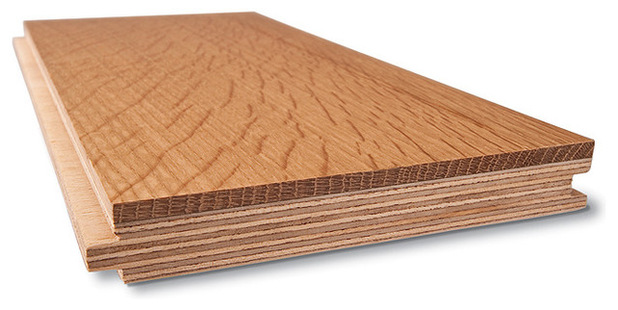One of the most commonly asked questions in a wood floor showroom by homeowners is as follows. “What should I choose for my house engineered hardwood or solid hardwood floor?”. It is a big mistake for a salesperson to respond with a definite answer without taking all of the following into consideration. Lifestyle, home structure, and even budget.
Engineered wood floors are available in a large spectrum of production costs. These methods often dictate the quality of types of engineered wood flooring. The purpose of this article is to ingrain you with the knowledge. Particularly on how engineered wood floors are made; so you can find the highest quality hardwood flooring in your budget.
Engineered Multiply vs 3-ply
Engineered wood floors constructed with hardwood veneer on top of the plywood are called multiply-engineered wood. While hardwood veneer on top of 2 layers of other softwood is called a 3-ply engineered wood floor. In hardwood floors, more layers do not necessarily translate into better performance. The balance and bonding of each layer should be taken into consideration first and foremost.
Lock vs Tongue & Groove
The two most popular styles used today for floating wood floors are the click-together and tongue-and-groove style planks.
Click-lock engineered hardwood offers a glue-less installation by a self-lock system on each plank. This increases the speed of installation and also offers a hidden benefit down the road. Repairs are easier with the click-together style because you can remove the damaged planks using un-clicking and reinstalling each plank.
Repairing Tongue & Groove wood floors can be tricky, considering the floor planks are glued together with hardwood flooring glue. However, Tongue & Groove engineered hardwood is more common because they are compatible with more forms of installation. These other methods include nail-down or glue-down.
Thick and Thin Veneer
The top layer (veneer) of an engineered floor is called the wear layer. The thickness of wear layers varies from paper-thin 0.6 mm to super thick 6 mm. Some of these wear layers can be refinished numerous times, while others should never risk sanding through the veneer. When looking at samples, view a side profile of the hardwood to determine the thickness of the wear layer. Hardwood veneers have a heavy influence on the cost of engineered wood production.
Rotary peeled vs Sawn-Cut Veneer
Rotary-peeled veneers are often found on entry-level products. They are peeled from a wood log-like apple skin. They are initially circular-shaped but are forced flat. This process increases the yield rate but is more prone to cracks from the wood’s natural tendency to curl. Most rotary-peeled hardwood will not be greater than 2 mm due to increased stress on the thick hardwood.
Dry-sawn wearlayers are available in different thicknesses from 2 to 6 millimeters (about ¼ inch). They are cut when the board has been kiln-dried and offer an identical look to solid hardwood. They can also be sanded at least once.
The biggest misconception about engineered wood flooring is that the products differ in durability from solid hardwood. If given a thick wear layer an engineered hardwood offers the same durability as a solid. When looking at stability (cupping or gaping) engineered flooring will outperform solid flooring. This means you can use a wider-width product without seeing those dimensional changes as much. However, that doesn’t mean we can just ignore moisture, especially relative humidity when it comes to engineered wood flooring. Engineered flooring is designed for normal living conditions and should abide by the same guidelines for relative humidity and temperature. If an engineered floor experiences dry conditions outside the parameters defined by the manufacturer, problems may arise. The engineered product may delaminate, show face-checking, split, and dry-cup—all problems that require plank replacement.
Up to this point, I hope you have learned enough about engineered hardwood floors to formulate your opinion on the quality of a product.


